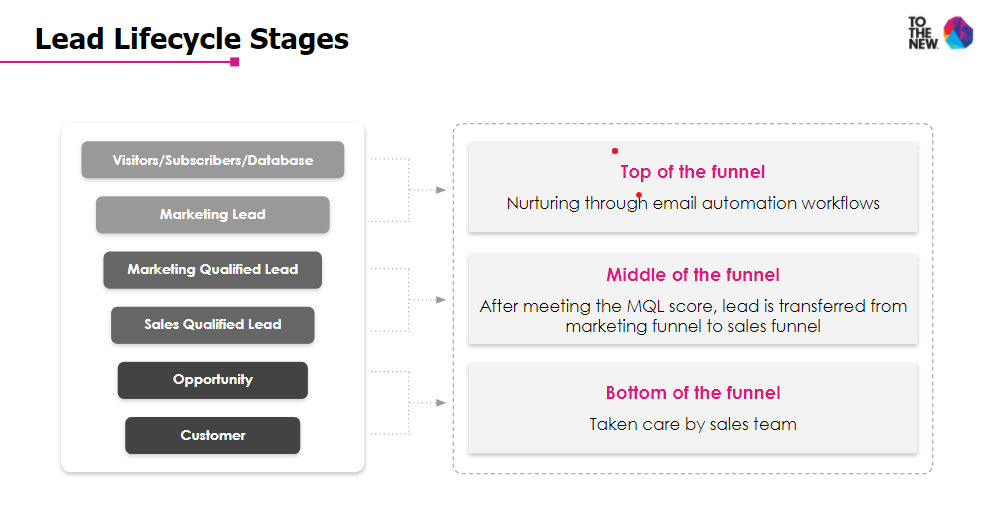How B2B Organizations Can Build a Winning Lead Lifecycle Management Strategy
Generating leads and successfully converting them into loyal paying customers is a top priority for most enterprises. However, capturing a lead’s interest is just one part of the process. In most cases, only a tiny percentage of generated leads end up becoming customers. It’s essential to pay special attention to every lead and efficiently navigate them through the sales pipeline. Poorly managed leads can result in wasted marketing efforts, lost revenue, and a drop in overall sales productivity. A comprehensive lead management process plays a huge role in accelerating the success of a company’s B2B marketing strategy. Once the leads start engaging with a brand, a well-organized lead lifecycle management strategy can close the gaps between sales and marketing, track leads’ behavior and patterns, and map their unique path across the lead lifecycle to drive conversion.
Rapid technological advancements and innovations have made it easier for companies to manage leads. Marketing automation, for instance, has seen widespread adoption in the marketing world. According to a recent HubSpot report, 76% of organizations leveraged marketing automation in 2021. Of the companies that didn’t use automation, 26% planned to adopt automation in 2021. Before we look at how marketing automation optimizes lead management, let’s first understand lead management.
What Is Lead Lifecycle Management?
Lead lifecycle management comprises a set of customer-acquisition processes and best practices to identify, analyze, qualify, and nurture the incoming leads to convert them into customers. The lead management process starts when a potential customer begins interacting with a business. It aligns the marketing and sales throughout different lead lifecycle stages, helping accurately determine whether a lead can be deemed ‘sales-qualified.’ This improved synergy helps close the leads and drive revenue for the company.
Stages of a Lead Lifecycle
Outlined below are different lead lifecycle stages that help marketers determine where a lead resides, what to do with it at each stage, and when it becomes ready to transfer to the sales team:

- Visitors or Subscribers: This person or organization has indicated they want to receive information about a brand but haven’t fully shown interest in purchasing its products. For example, if someone signs up for a company’s newsletter or blog, they reside at a visitor/subscriber stage.
- Marketing Lead: A visitor turns into a marketing lead once they have engaged with a brand in a way ( fills a contact form, downloads an e-book or a guide, etc.) that shows their interest in the company’s products. At this stage, companies can collect some data about the person, such as their name, company name, company size, etc. Both visitors and marketing leads lie at the top of the sales funnel.
- Marketing Qualified Lead (MQL): At this stage, marketing leads have shown genuine interest in knowing more about the company’s products and services. Some examples include downloading middle-of-the-funnel content (e.g., customer case studies, product demos, etc.) and visiting a brand’s product page frequently within a short time. It is considered more likely to become a customer and gets transferred to the sales team for a follow-up.
- Sales Qualified Lead (SQL): This stage indicates that MQLs are close to purchasing a product but haven’t converted into full-fledged opportunities. The sales team decides whether an MQL is ready to convert into a sales-qualified lead. SQL examples include a person or organization asking for a product quote, live demo call, or other product purchase-related information.
- Sales Qualified Opportunity (SQO): At this stage, a lead is seriously considering a brand’s services and is well on its way to pursuing a deal. It indicates that the lead has greater detail about a product (e.g., price, key offerings, etc.) and considers it a feasible solution for their needs. It’s a crucial bottom-of-the-funnel stage where a company may need to answer the last additional questions about their solution or services to the SQO.
- Customer: The deal gets signed at this stage, and SQOs convert into paying customers. Beyond this stage, a customer service team’s responsibility is to maintain a good relationship and ensure the customer is satisfied with the product.
Phases of Lead Lifecycle Management Process
A solid lead management process efficiently moves the lead through the sales funnel and converts it into a customer. Following are the different phases of an efficient lead lifecycle management process:
- Lead Capturing: This phase involves enticing visitors in the lead lifecycle through valuable information (e.g., blogs, guides, social media ads, email marketing, etc.) and encourages them to provide relevant details such as name, email address, job title, company’s name, etc., in exchange. Leads can be captured through different sources, including popup forms, webinars, email CTAs, etc. The data collected helps marketers determine the leads worth pursuing.
- Lead Enrichment & Tracking: The second phase of a lead management process includes lead enrichment and tracking. Lead tracking helps identify the source of leads (inbound or outbound), gauge their activities (content assets downloads, link clicks, email engagement, etc.), and determine where they fall in the sales funnel. Lead enrichment involves verifying, correcting, and updating lead information such as contact details, company size, industry, etc., in a database to ensure accuracy before sending it off to the sales team.
- Lead Qualification: This process involves carefully assessing the leads most likely to convert into customers. Many factors are taken into account during the lead qualification process, including the lead’s intent to buy, business needs, budget issues, purchase timeline, etc. Without proper lead qualification, organizations risk chasing leads that don’t fit their established customer profile.
- Lead Distribution: Once the leads have been captured, tracked, and qualified, they are assigned to the sales team, and this process is known as lead distribution. A solid lead distribution process involves carefully analyzing the leads and matching each lead to the sales development rep (SDR) with relevant expertise and experience to close the deal successfully.
- Lead Nurturing: This phase involves continually engaging and educating visitors about a company’s product across every stage of the lead lifecycle journey through marketing activities. Some common lead nurturing activities include building an effective email marketing campaign, sending personalized follow-up emails, and engaging visitors with events, webinars, newsletters, digital ads, etc. It helps companies understand the needs of potential customers, stay in touch with them, build brand awareness, and continue the conversation with leads that are not ready to purchase a company’s product.
Role of Marketing Automation in Driving Successful Lead Lifecycle Management
Marketing automation serves as a backbone in optimizing a company’s lead management efforts. It is the process of using software to automate several repetitive marketing workflows, build a personalized experience for customers, and boost overall efficiency. Whether gathering valuable data about leads, seamlessly tracking them, or successfully nurturing them, marketing automation has a huge role in building a powerful lead lifecycle management strategy. Outlined below are ways marketing automation helps implement a robust lead management process.
Gathering Valuable Lead Data
Marketing automation helps strategically collect valuable lead data throughout the sales pipeline. It does so through progressive profiling that focuses on gradually gathering relevant information about the leads at different sales funnel stages instead of asking for too much information at once. This prevents the potential customer from getting overwhelmed. Many marketing automation tools enable progressive profiling through ‘dynamic forms’ functionality that displays new fields for information on every form submission to gain more details about a lead naturally. Creating a detailed profile of a potential customer helps drive personalized communication, improve content distribution, and accelerate lead conversion. Similarly, companies can build dynamic landing pages and responsive email templates using marketing automation tools to send customized messages to prospects based on their unique traits.
Effective Lead Enrichment
Marketing automation helps streamline the lead enrichment process, ensuring that the leads loaded in the system are high-quality, verified, and updated. If a lead lacks crucial information, it cannot be considered actionable. Filling the gaps through spreadsheet imports and data entry is a heavily manual, time-consuming, and error-prone process that can significantly slow down the sales follow-up process. By automating lead enrichment, companies can send complete lead information without any missing value to SDRs, which, in turn, drives more personalized communication with prospects.
Optimized Lead Nurturing Process
Marketing automation helps boost lead nurturing efforts in many ways. For instance, email marketing automation triggers and sends personalized emails to the leads when they take a specific action such as whitepaper downloads, form fills, etc. To deliver a customized email, marketing automation tools leverage the stored lead data such as name, location, past purchase history, etc. Marketing automation further helps improve visibility between the sales and marketing team, enhancing the lead nurturing process. By linking marketing automation with CRM, both sales and marketing teams can track a lead’s journey and send back the leads not ready for conversion into a nurturing campaign. Furthermore, marketing automation tools provide lead segmentation, where marketers categorize the leads based on different attributes such as demographic, industry, job title, etc. This helps create hyper-personalized nurturing campaigns, thereby increasing the chances of lead conversion.
Tracking Lead Behavior and Activities
Marketing automation can provide detailed insights into the behavior and activity of potential customers. By leveraging behavioral tracking features in a marketing automation tool, the marketing and sales team can analyze the source of a lead and its movement through the company’s website. Based on lead actions and overall engagement with the brand, marketers can gauge where it resides in the sales funnel. It enables companies to take appropriate steps and fine-tune their activities across multiple touchpoints to qualify and convert the lead.
Similarly, A/B testing and multivariate testing offered in marketing automation tools can give insights into what version of an email or a web page works best to engage their potential customers. Many marketing automation tools offer built-in intuitive dashboards and reporting capabilities based on data stored in the automation tool, CRM system, and Google analytics. It gives companies a clear picture of their marketing efforts to help adjust their lead engagement activities accordingly.
Lead Scoring for More Qualified Leads
Marketing automation tools provide a lead scoring functionality that enables marketers to analyze if the nurtured leads are ‘marketing qualified.’ It works by assigning a total score to a lead based on actions taken across the sales pipeline, such as viewing specific pages, email actions, specific downloads, completing forms, requesting product demos, etc. The resulting lead score determines how interested a lead is in purchasing a company’s product or services. Every company has its unique threshold at which a lead gets deemed qualified. Once qualified, it gets sent to the sales team.
Automated Lead Routing
Marketing automation helps automate the lead routing process by seamlessly and intelligently matching leads to an appropriate SDR to accelerate chances of lead conversion. Lead routing functionality in marketing automation tools matches leads based on many pre-defined factors. These include lead source, geography, sales rep’s expertise, experience, current workload, etc. It ensures leads get assigned to the right sales rep to improve chances of conversion. Marketing automation boosts efficiency across the lead management process by curtailing the need for a manual time-consuming lead routing approach.
Conclusion
Lead lifecycle management can drive significant revenue, generate high-quality leads, build brand recognition, and boost awareness. A high-performing lead lifecycle management strategy depends on how a business leverages its resources and valuable lead data to engage with potential customers. Marketing automation plays a huge role in helping companies maximize value from their lead management efforts and manage the lead lifecycle at scale.
If you are interested in learning more about how marketing automation can optimize lead management, feel free to connect with our marketing wizards.



